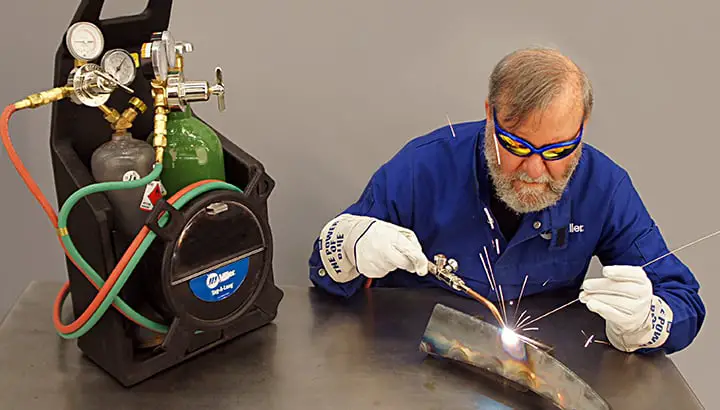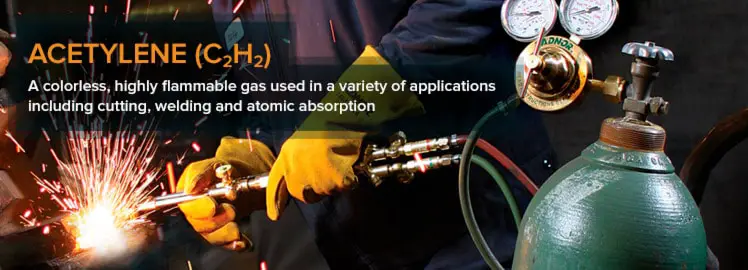Being one of the most inflammable gases used in welding, acetylene has a special place in the welding world. This gas is however considered to be of extreme importance only in certain specific areas. It is not used in every type of welding and we will see today whether acetylene gas is suitable for TIG welding and its respective reasons.

No, acetylene gas is never seen as a plausible option for TIG welding. Acetylene gas is a highly inflammable gas that is primarily used for Gas welding. TIG on the other hand requires gases that can go with the properties of the tungsten electrodes used in welding. Understanding the properties of each can help you in learning why it is so.
This blog will help you with the same. So continue reading…
When is Acetylene gas used in welding?
If you have heard about gas welding, then that is the answer. Gas welding is a type of welding that uses the combination of acetylene gas and mostly oxygen to create a flame that is quite hot. With the highly inflammable properties of acetylene, creating a good temperature to melt a metal is not a hard job.
The welding technique that employs this combination of gases is called oxy-acetylene welding. This combination is especially preferred to raise the temperature close to 1500 degrees Celsius, hot enough to weld steel. Oxy-acetylene welding is a flexible combination and covers various metals such as stainless steel, copper, and aluminum.
Similarly, gas welding uses gases like propane, coal gas, and hydrogen along with oxygen for other metals especially non-ferrous ones that require a much lower melting point.
What are the properties of acetylene gas that make it Not suitable for TIG welding?
Three factors that make acetylene gas unsuitable for TIG welding are as follows:
1.) Highly flammable: Triple bond, the element that makes acetylene gas the hottest among the fuel gases also makes it the most flammable gas of all. If the gas is subjected to ignition or shock, then the triple bond breaks decomposing carbon and hydrogen molecules thereby creating an atmosphere ready for explosion.

For TIG welding this is extremely dangerous as the electricity and current are much-needed elements. These will never be able to go with the flammable property of acetylene gas.
2.) Dangerous than other gas mixtures: The same flammable nature of acetylene gas makes it more dangerous than other gas mixtures. When combined with air, dealing with this gas can be quite risky unlike the usual Argon combinations used in TIG.
3.) Not suitable like the deoxidized tungsten rods: Tungsten rods are deoxidized in nature unlike the brazen rods or flux coated oxy-acetylene rods used in gas welding.
Due to this, the usage of the rods having the combination of acetylene and oxygen can give you trouble while TIG welding. The weld puddle will be bubbly and this will prevent you from keeping the arc distance stable.
Argon Vs Acetylene gas
Argon is majorly used for TIG. Due to its inert nature, Argon is considered the apt gas that goes with the properties of TIG. When the gas is non-reactive, tungsten rods used in TIG are safe from oxidization or rust.
And Argon just serves this purpose perfectly. Argon is used for TIG in numerous welding applications along with other gases like hydrogen, CO2, helium, etc.
So let’s see how Argon is different from acetylene gas on different terms.
| Acetylene gas | Argon gas | |
| Flammable | Yes | No |
| Nature | Active | Inert |
| Versatility | High | Low |
| Cost | Low | Low |
| Density | Lighter than air | Denser than air |
| Toxic | No | No |
| Safe | Yes | Yes |
Why should I prefer oxy-acetylene gas welding over TIG?
Like any other methods, TIG and gas welding have their advantages and drawbacks. Yet, in this section, I am going to tell you in what areas oxy-acetylene gas welding scores better than TIG.
1.) Price: A TIG welder along with its equipment can easily cost you more than gas welding. While you spend close to $1000 for a TIG machine, you can get hold of a gas welding torch at one-fourth the cost. When added with other benefits of gas welding, people often prefer it rather than going for other costlier options.
3.) Versatility: Acetylene gas by itself is extremely versatile in nature. And, when it is combined with oxygen the overall capability of the gas increases. Gas welding is therefore not only applicable for melting metals, but also brazing, bending metal, and silver soldering.
4.) Portability: For TIG welding, there are a bunch of things that come into play. TIG welding machine, torch or electrode holder, filler metal rod, and shielding gas supply are only a few among the requirements.
Whereas for gas welding, for instance, oxy-acetylene gas welding all you need are a cylinder, torch, pressure regulator, and safety accessories. That’s it! You can save all the trouble of carrying loads of things with you while you move from one place to another.
See also: What kind of Gas to use for TIG welding
But why is it that the welding world still recommends TIG over oxy-acetylene welding in most cases? Let’s see…
Safety of workplace: Of course, Argon is much safer than acetylene gas. Even though Acetylene gas is not dangerous in nature, it is still quite risky to use it in an environment that involves elements that are used to charge other equipment.
A spark or a fire can create a situation so bad that you may find it difficult to escape from it. A minute carelessness can lead to a huge accident as the gas is highly inflammable. Argon on the other hand is only dangerous if you are working in a very constrained place where you tend to breathe in a huge quantity at once.
Fumes and smoke come as a package along with oxy-acetylene gas welding. And these fumes unlike in TIG come from the burning arc itself. In the case of TIG, fumes are the result of welded metal and not the arc, rendering them unharmful.
However, for both gases, cylinders need to be kept in a place with low temperatures. Even in this case, acetylene gas cylinders come in highly pressurized cylinders, much higher than Argon and 20 times the atmospheric pressure (varies from 300 psi- 500 psi). A hot and pressurized external environment can lead to gas cylinders exploding irrespective of what gas they carry.
Better finishing of the weld: TIG welding although having entered into the world welding years before, over the decades it has improved its techniques with developments and inclusion of modern equipment into the procedure.
The precision of welding of TIG cannot be compared with oxy-acetylene. With TIG, you get good welds even in the tiniest of areas. The weld beads have a better profile and the overall look will be aesthetic. In a nutshell, the weld finish and effectiveness that you get from employing this method are much better than oxy-acetylene gas welding.
Better Operational effectiveness: Oxy-acetylene welding requires the welder to do multiple recharges of their main component whereas for TIG this is not a problem. Gas cylinders for the former need to be refilled more times than for the latter.
How TIG and oxy-acetylene work on different metals?
| Metal | Elements | Oxy-acetylene welding | TIG welding |
| Stainless |
|
|
|
| Aluminium |
|
|
|
| Steel |
|
|
|
| Cast Iron |
|
|
|
| Copper |
|
|
|
FAQ
What are the properties of Acetylene flame?
Acetylene flame is composed of Carbon and Hydrogen. The presence of carbon gives the flame a high temperature thereby making it suitable to weld even the hardest of metals.
Lack of oxygen can however create problems due to the considerable amount of carbon in the flame. Without enough oxygen, carbon gets transformed into sooty black smuts.
In neutral oxy-acetylene flame, oxygen is added in a limited amount giving priority to carbon to transfer the latter onto the surface for certain metals with hard surfacing operations.
In the case of steel, the combination of oxy-acetylene works in a reducing nature making iron oxide into iron (oxygen burns). Due to this, there is no need for flux for welding steel with oxy-acetylene flame.
What are the three different types of acetylene flame?
Neutral flame: This is the common oxy-acetylene flame, where equal quantities of oxygen and acetylene are burned.
Carburizing flame: An excess of acetylene in the flame makes it suitable to create a carbon-rich zone of heating.
Oxidizing flame: Oxygen-rich zone of heating is created with the excess presence of oxygen in the flame. This is achieved by starting the flame as neutral and reducing the fuel gas gradually.
What are the three major techniques involved in oxy-acetylene welding?
Leftward technique: Exclusively used in oxy-acetylene welding, majorly for welding fillet, butt, and lap joints with thickness up to 5mm.
Rightward technique: For welding application involving metals of more than 5mm thickness (flat and horizontal-vertical positions).
All-positional rightward flame: Being a modified version of the previous one, this technique is majorly used for vertical and overhead welding.
The latter two enable the welders to have a weld with uniform penetration along with better control of metal to be welded and weld pool.
Ease of movement and clear visibility of the weld pool is ensured in these. Even then only highly skilled welders do these techniques and are therefore considered to be unconventional methods in the welding world.
EndNote
Despite the technical advancements in arc welding, the effectiveness of acetylene gas has helped oxy-acetylene gas welding continue its importance in the welding field. Acetylene gas has unique properties that make it only suitable for gas welding.
It is the only fuel gas that works best for gas welding with its incredible capacity to generate heat. TIG, therefore, is out of the question here. Acetylene gas is never an option for a smooth TIG weld.







